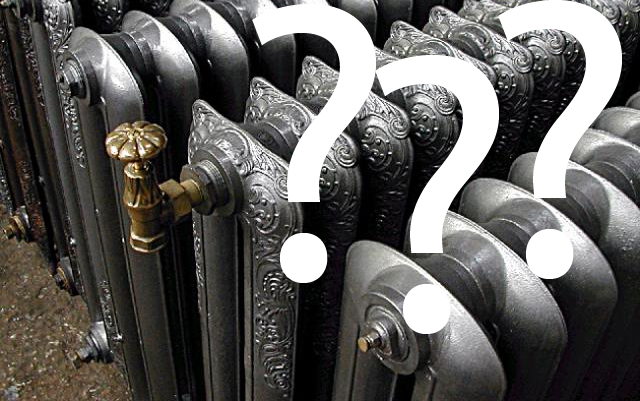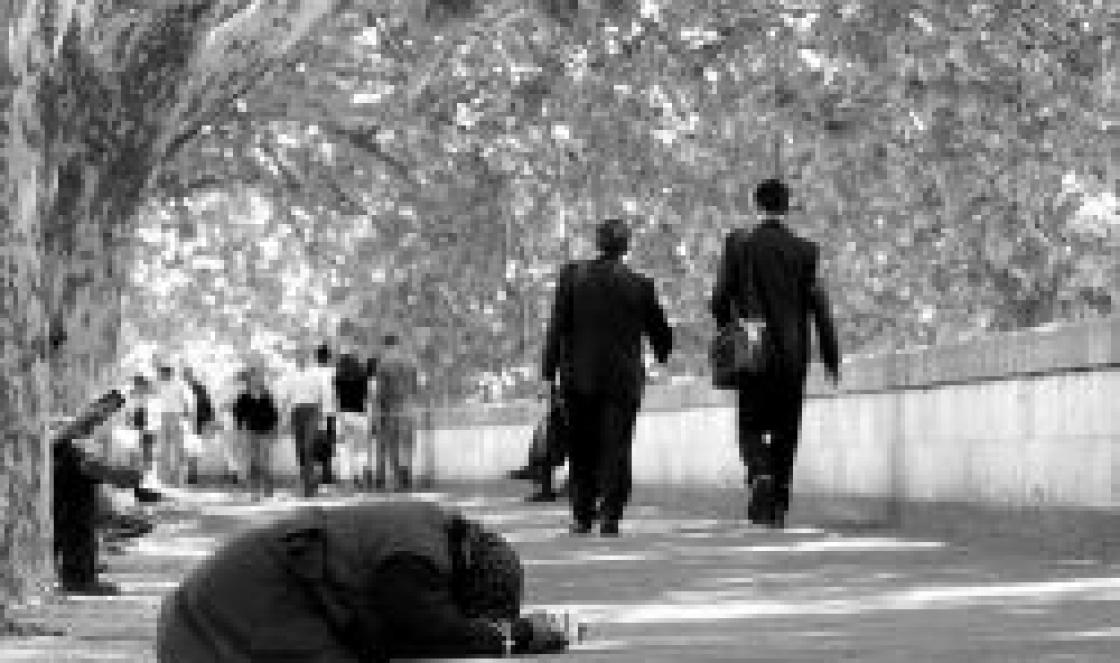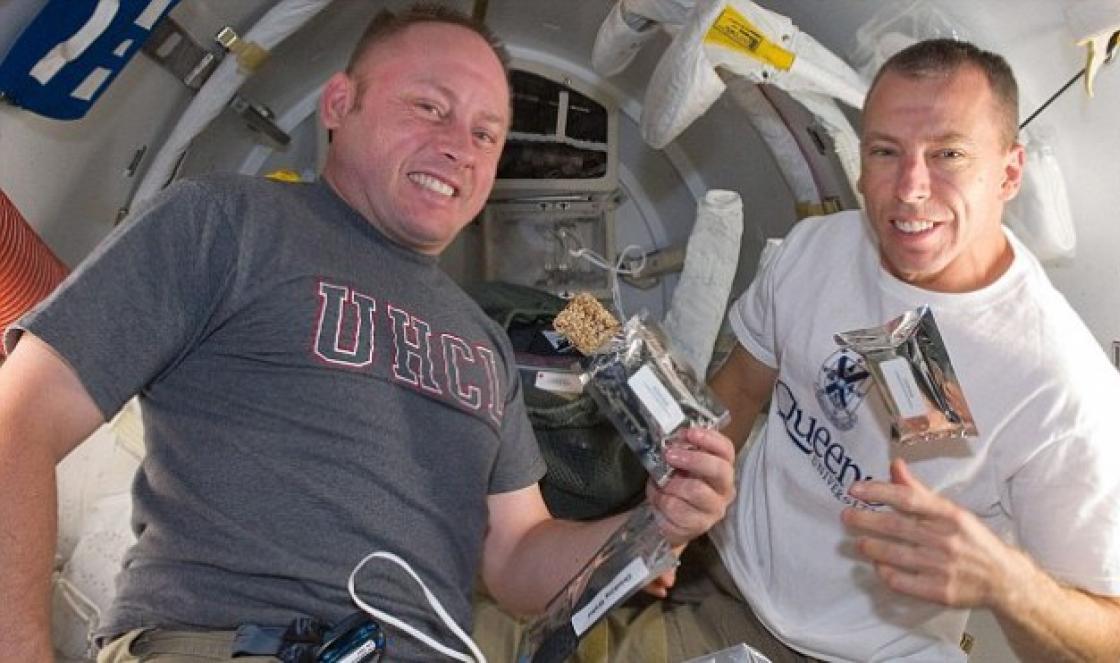Children, of course, delight!
Climbing into a washing machine, climbing onto a giant chair or lying in a washbasin the size of a mini-pool - like scenes from the movie "Honey, I Shrunk Our Children" or lines from the book "The Adventures of Karik and Vali".
Only in Moscow there is a place where all this is real
2. The Moscow giant, of course, is a modern man. In the hallway, he has an iPod and iPhone lying around, among which the hostess, who receives guests, comfortably settled down. 
3. From the hallway you get to the kitchen, where a giant baby doll from Soviet childhood sits on a huge table.
A baby doll the size of an average family put together. 
4. What do we have for lunch there? Borscht on the stove 
5. You need to be careful with the microwave. Those who misbehave are put there to roast with grilled chicken. 
6. If the microwave is busy, you will be sent to the washing machine, the main thing is that there is no claustrophobia and everything is in order with the vestibular apparatus 
7. Linen is dried here.
Who can guess the size? 
8. In general, in the giant's house you need to be extremely careful.
To avoid accidents 
9. Giant's bathroom.
In principle, if you draw water into the washbasin, it can play the role of a pool 
10. Dad, use the plunger....... 
11. House through the eyes of a Soviet baby doll.
The people here seem tiny 
12. About the same 
13. Living room and giant armchair 
14. Be careful, you can fall into a jar of condensed milk 
15. Smoking is harmful 
16. Feel like a star on the catwalk 
17. Watch Out... Cockroaches Are Giant Too 
18. Trying to steal the giant's shoes...
Heavy ((((It did not work ... 
The giant's house is located in Moscow, in the very center - on Arbat, 16.
By the way, bloggers are promised free entry)
My previous photo essays and photo stories:
When using materials or photographs, an active link to the source is required
Saved
Target: Create conditions for repeating and practicing the spelling of words with a separating hard or separating soft sign.
Tasks:
Systematize knowledge about the spelling of words with this spelling.
Improve the skills of analysis and synthesis.
Develop reflective skills and abilities.
· Analysis of word structure.
· Possession of the skills of analysis, reasoning from particular phenomena to general patterns, synthesis and creation of a scheme of the studied linguistic phenomenon.
· Ability to formulate, argue and express an opinion in the course of a collective discussion.
Planned results
Personal Outcomes
· Awareness of the special role of the letters b and b sign in the Russian language.
Development of the need for independent initiative reading, possible access to an individual subject project "Tales and poems about b and b signs"
Metasubject Results
Cognitive results
predict the learning situation;
build reasoning from particular phenomena to general patterns;
Summarize the received information;
Regulatory results
identify their own problems and relate them to the topic and purpose of the lesson;
independently formulate learning tasks for the lesson, work plan;
Perform individual and team assignments different kind in accordance with the goal;
evaluate their activities, arguing the reasons for achieving or not achieving the planned result.
Communication results
· argue your position and express it in the course of a collective discussion;
adequately use speech means, evaluate their actions, evaluate the result;
display in speech the content of their actions.
Subject Results
Knowledge of the rules for choosing the right letter when spelling words with a given spelling.
Formation of skill practical application rules, graphic designation of spelling.
Download:
Preview:
Subject: Separating b and b signs. Generalization of the studied material.
Target: Create conditions for repeating and practicing the spelling of words with a separating hard or separating soft sign.
Tasks:
- To systematize knowledge about the spelling of words with a given spelling.
- Improve your analysis and synthesis skills.
- Develop reflective skills and abilities.
The main content of the topic, terms and concepts
- Word structure analysis.
- Possession of the skills of analysis, reasoning from particular phenomena to general patterns, synthesis and creation of a scheme of the studied linguistic phenomenon.
- Ability to formulate, argue and express an opinion in the course of a collective discussion.
Planned results
Personal Outcomes
- Awareness of the special role of the letters b and b sign in the Russian language.
- Development of the need for independent initiative reading, possible access to the individual subject project "Tales and poems about b and b signs"
Metasubject Results
Cognitive results
- predict the learning situation;
- build reasoning from particular phenomena to general patterns;
- summarize the information received;
Regulatory results
- identify their own problems and relate them to the topic and purpose of the lesson;
- independently formulate learning objectives for the lesson, work plan;
- perform individual and collective tasks of various types in accordance with the goal;
- evaluate their activities, arguing the reasons for achieving or not achieving the planned result.
Communication results
- argue your position and express it in the course of a collective discussion;
- adequately use speech means, evaluate their actions, evaluate the result;
- display the content of their actions in speech.
Subject Results
- Knowing the rules for choosing the right letter when spelling words with a given spelling.
- Formation of the skill of practical application of the rule, graphic designation of the spelling.
During the classes
Stages | Educational | Teacher activity | Activities carried out | Forms | Formed Skills |
1. Motivation (self-determination) | Emotional, psychological and motivational preparation of students for the assimilation of the studied material | Hello! Greet each other: Shoulder partners give five to each other; partners in the face - bang your fists and smile at each other. Introduction. - Sit comfortably. Today we will work in pairs and groups. And what do we need for this? Let's try to remember the rules of conduct with the help of a short poem. I start the line, you continue, do not forget to raise your hand, do not interrupt your comrade. Be diligent in class Be calm and...(attentive). All write, do not lag behind, Listen, don't ... (interrupting). Speak clearly, clearly For everything to be ... (understandable). If you want to answer You need a hand ... (raise). Be diligent in class Don't talk: you don't...(forty) . If a friend began to answer, Don't rush ... (interrupt). And if you want to help a friend - Take it easy...(hand). - That is, in relation to the partner, we should be: .... For working in groups today in the lesson, you will receive tokens. We will summarize at the end of the lesson. | Listen to teachers, participate | Frontal | Personal: have a positive attitude to learning, cognitive activity, they want to acquire new knowledge, skills, improve existing ones. Cognitive: understand the cognitive task. Regulatory: plan (in cooperation with the teacher and classmates or independently) the necessary actions, operations. Communicative:work in pairs (exchange views, learn to understand the partner’s position, including those different from their own) |
2 . Setting goals and objectives for the lesson. Motivation of educational activity of students. | Determining the topic of the lesson FINK-RIGHT-ROUND ROBIN(“think-write-discuss in a team.” During this structure, participants think about a statement or answer to a question, write down and take turns discussing their answers in a team | Open your notebooks, write down today's date. To determine the topic of our lesson, solve riddles, write down the answers in a notebook. After I read the last riddle, after consulting in my group, name the topic of the lesson. 1) These little birds Sing great masters On a birch among the branches Trill start ... (nightingales) 2) Without what in the world Adults can not live and children? Who will support you friends? Your friendly ... (family) 3) A leaflet hangs on a pole, there are few lines in it, “buy”, “sell” or “change”, “give away”(announcement) 4)
From sand, dry blades of grass, 5) Insert the key into the intercom, click and ended up in it(entrance) 6
)
Who all night long Look at words, analyze them, consult in groups,what is the topic of the lesson? Separating b and b signs Write the topic in your notebook! And to determine the objectives of the lesson, we write a sentence With… huddled from in… south a sparrow… and on trees… yah. What did you need to write down the proposal? What tasks will we set for ourselves? Tasks: What else do you need? 1) We must remember the rule 2) how to write words with ь and ъ sign And most importantly... 3) bring our knowledge about b and b signs into the system | Answer questions, build clear statements for the partner | group | Personal: are motivated to learn. Cognitive: perform educational and cognitive actions in a materialized noah and mental form; carry out logical operations to solve educational problems. Regulatory: accept and save the learning task. Communicative:ask questions, listen and answer questions of others, formulate their own thoughts, express and justify their point of view |
3. Actualization of knowledge. | Testing the assimilation of materials.SIMALTINIUSS ROUND TABLE perform written assignments, and at the end pass them around to a neighbor for verification THOUGHTS ON THE DESK | To check how well you know the rule, we will perform various tasks. The first task is called Dictation "Plus - minus." You write down words from dictation if the word is written with a dividing soft or solid sign, then put a plus, if it is not written, then put a minus. Drink, hare, icicle, vegetable, ate, woman, hospital, mail, loach, wedge, departure heart, street, hugs First, CHECK EACH OTHER, pass the notebooks to the person who is sitting opposite - your partners in the face, Now, use the standard, pay attention to the correctness of the task performed The next task is called Thoughts on the table. Don't forget, the work is collaborative I suggest that you write down only 8 words per rule passed. Then everyone, in turn, in a circle explains the spelling of his word, the guys in the group can correct a friend, if necessary 1 In ... south, 2 from ... rides, 3 p ... esa, 4 s ... there, 5 bul ... he, 6 s ... capacity, 7 champagne ... he, 8 bearish For the final checkuse the standard Reflection Did the job cause problems? Were there any mistakes? Why do you think? What needs to be done to eliminate these difficulties (Repeat the rule, i.e. systematize our knowledge) To do this, open the textbooks on p. 114, everyone will read the rule again on their own. Then, each group receives a task - these are the words for the passed rule, the spelling in which you must explain b or b. For the answer, you will select 1 student in the group. Groups receive words: MONKEY SHOOTING BOUILLON INTERVIEW ANNOUNCEMENT Advise and respond Each group gets a token for a correct explanation. Fine. We repeated the rule. What else do you think we need to think through or come up with to bring our knowledge into a system? Think over a reference scheme that you can rely on for the use of b and b signs | Formulate their own thoughts, express and justify their point of view; in collaboration with the teacher and classmates draw conclusions. | Group, individual. | Personal: have a desire to be aware of their difficulties and strive to overcome them; demonstrate the ability to self-evaluate their actions, deeds. Cognitive: establish causal relationships, draw conclusions. Regulatory: realize the insufficiency of their knowledge. Communicative:asking questions to get the information needed to solve a problem. |
4. Generalization and systematization of knowledge Preparing students for generalized activities Reproduction on a new level (reformulated surveys). | Generalization QUIZ QUIZ TRADE COLLECT IDEAS. ROUND TABE) | To bring our knowledge into a system, we need teamwork, all your knowledge on the topic covered, GET OUR IDEAS TOGETHER! To do this, each group receives its own task: 1 group will have to come up with a reference diagram with examples for the separating b signillustrating the rule Group 2 will have to come up with a reference diagram with examples for the dividing b signillustrating the rule 3 group will have to come up with a scheme for exceptions 4 group come up with their own algorithm for writing the ь sign, explain with an example Group 5 come up with their own algorithm for writing the sign, explain with an example Scheme for 1 group Scheme for group 2 For group 3 For 4 groups 2) If it is ...., check which letter it ends with and which letter ... is before 3) If .... ends with ...., then before letters e, e, u, i is written….. For group 5 1) Determine .... words where the spelling is ... sign 4) If this is a spelling in ...., before the letters ... .. it is written ... ... .. 5) In some words of foreign origin, it is written ... .. before the letter .... and these words are necessary……(……….) After you have prepared, the 2nd member of the group goes to the board and announces the rule Reflection Receive tokens for a correctly completed task Well done! What did we get? Your collective work has helped us together in a short time to create schemes that will help you cope with any task for the passed rule!!! Now that we have managed to create both the circuit and the algorithm, what are you ready for? To the application of the rule in practice! Complete tasks without errors!
Each group has a text about the giant Eating, the text is passed around in a circle in the group, you must insert the missing letters into it, consulting, using the resulting algorithm, And as soon as the letters are inserted, the text is posted by 3 responders and is checked against the standard. Time has gone. "Giant Ob...atelo was visiting." “They gave him treats ... me. Varen… me and salty… me. Bad ... yu broth. Puff pies. Olad ... and yes pancakes. Bull ... and tails and chickens ... and wings. He drank, ate, ate, ate, ate a lot, but he remained hungry as he was. Reflection Well done, coped with the task, applying the scheme. Get Tokens | In cooperation with the teacher and classmates, they draw conclusions, complete a written task in rows, work | Frontal, individual | Personal: aware of their learning potential. Cognitive: extract the necessary information from the listened explanation of the teacher, the statements of classmates, systematize their own knowledge. Regulatory: plan the necessary actions, operations, act according to the plan. Communicative:build small monologues, carry out joint activities, taking into account specific educational and cognitive tasks |
5. Control of assimilation, discussion of the mistakes made and their correction. | Disclosure of the essence of new concepts, assimilation of new ways of educational and mental activity of students. BROWNIAN MOTION FRIENDS BY TIME Round Robin | Task 2 The next task for the speed of your reaction and attentiveness The team must find words throughout the class and distribute them according to the rule. Listen to the task carefully. In the class, words are fixed for the passed rule, your task is to find them and fix them on the board. In total, the members of each group must find and fix 5 words on the board. I turn on the music and as long as it plays, the members of the group search for the words. As soon as the music ends, everyone except the 4 students who will answer sit down in their seats. Listen carefully! Tasks for groups will be very different Task for 1 group Find exception words where the separator character is written before the letter O Task for group 2 Find words with a separating sign at the root of the word friends at night Task for group 3 Find words with a separator ъ after prefixes Task for group 4 Find words where there is no ь separating sign (ъ in these words softening) door Task for group 5 Find words where there is no dividing sign ь (ь in these words is written with nouns and verbs after hissing) Get carried away, blush, rye, meet Summarizing Number 4 reads words, check Reflection What helped you complete the task correctly? Task 3 is called CORRECT THE MISTAKE You will have to correct mistakes in words with a separator ь and ъ sign, passing the task in a circle in a group. You can check and correct each other, think together. At the end of the task, you will enter in the answer of the task the number of inserted ь and ъ characters I turn on the music - Time has gone, turn it off - it's over Cross out and correct each group in your text
Answer: In the corrected words, it turned out to be dividing ... .. b signs and .... b signs. Answer: 9-th and 5-th Reflection For the right amount b 1 token, b 1 more token | Take part in training game, answer questions, complete tasks | group, individual | Personal: willing to acquire new knowledge, skills, improve existing ones. Cognitive: read Regulatory: control learning activities, notice mistakes made; understand the rule of control and use it successfully Communicative:carry out joint activities in pairs and working groups, taking into account specific educational and cognitive tasks,able to ask questions to clarify the sequence of work |
Reflection (summarizing the lesson) Analysis and content of the results of the work, the formation of conclusions on the studied material DZ | CORNERS CONERS | Summing up the work in groups Token Counting See how much knowledge in the form of tokens you have earned. I think it says that your knowledge is brought into the system. Well done, the work in groups turned out. Reflection Angles And in order for everyone to be able to evaluate their work in the lesson, you must go to the corners, depending on how you evaluate what you have achieved today in the lesson 1 corner in 1 corner go those of the guys who coped with all the tasks, understood the topic well, can help 2 corner those guys who coped with all the tasks without difficulty go to the second corner, but they cannot help in explaining the material 3 corner those guys who completed the tasks go to the third corner, but they still need help 4 corner those guys who generally mastered the topic, but made mistakes, will stand up You see how well you did, now you can play the role of a teacher and explain the topic to a friend. 1) write an essay about the role of b and b signs or a fairy tale about b and b signs or rule and exercise 82 | Generalization | Individual | Personal: have a desire to learn new activities, to participate Cognitive: perform educational and cognitive actions in a materialized and mental form; carry out operations of analysis, synthesis, comparison, classification to solve educational problems, establish cause-and-effect relationships, make generalizations, conclusions. Dictation "Plus - minus" I drink (+), hare (+), entry (+), beat (+), postman (-), vegetable (-), ate (+), woman (-), mail (-) , loach (+) , departure (+) , street (-) , hugs (+) , heart (-) Thoughts on the table Blizzard, departure, play, eat, broth, shooting, champignon, bearish Explanation of the use of ъ and ъ signs Group 1 MONKEY Group 2 SHOOTING Group 3 BROTH Group 4 INTERVIEW Group 5 COLLECT IDEAS 1 group - scheme for b 2 group - scheme for b 3 group - scheme for exceptions 4 group - algorithm for writing ъ sign 5 group - algorithm for writing ъ sign APPLY THE RULE “The Giant O…atelo was visiting” “They put out a treat for him…I. Varen… me and salty… me. Bad ... yu bul ... she. Puff pies. Olad ... and yes pancakes. Bull ... and tails and chickens ... and wings. He drank, ate, ate, ate, ate a lot, but he remained hungry as he was. ” “The giant Ob atelo was visiting” “They put out a treat for him. Varenya and salty. Bad yu bul she. Puff pies. Olad and yes pancakes. Bull and tails and chickens and wings. He drank, ate, ate a lot, but he remained hungry as he was. APPLY THE RULE Task for group 1 Find exception words where the separator sign is written before the letter O Task for group 2 Find words with a separator b at the root of the word Task for group 3 Find words with a separator b after prefixes Task for group 4 Find words , where there is no s separating sign (b softening) Task for group 5 Find words where there is no separating s sign (s written after hissing in nouns and verbs of the 2nd person) CORRECT THE MISTAKE is sewing a dress the murmuring of a stream eating leaves shooting a monkey drove to the entrance to dine with jam bird families and an evil blizzard CORRECT THE MISTAKE Answer: In the corrected words, it turned out to be dividing ... .. b signs and .... b signs. CORRECT THE MISTAKE Answer: In the corrected words, there are 9 b signs and 5 b signs. Summing up in groups Reflection 1) Stand at the table of the 1st group, those of the guys who coped with all the tasks understood the topic well, can help 2) Stand at the table of the 2nd group, those of the guys who coped with all the tasks without difficulty 3) Stand at table 3 groups those of the guys who coped with the tasks, but find it difficult to explain the topic 4) Stand at the table 4 groups those of the guys who coped, but he needs help Homework 1) write an essay about the role of b and b signs 2) come up with a fairy tale about b and b signs 3) rule and exercise 82 We explain which letters are missing The homeland of the Russian samovar is the city of Tula. In Rus', samovars of various shapes and volumes have long been made. There were even samovars with removable handles. The Russian family loves to sit by the samovar. The proverb says: "Whoever drinks tea will live for a hundred years." Spelling of the separating b and b signs 1. In which (their) word(s) is the separating b written? kloch...I wrote...mo in...driving with...to narrow down n...esa 2. Which word(s) does not contain a separating b? in...south under...driving in...driving vol...em medal...he 3 . In which word(s) is the separating ь written? a call ... a call between ... a language fell ... then about ... a monkey ... yana 4. Which word does not contain a separating b? det. Test yourself: 1- 1.5; 2-1.5; 3 - 2.5; 4 - 2.4 Municipal budgetary educational institution high school №19 urban district - the city of Kamyshin Volgograd region Legal address:city of Kamyshin, microdistrict 5, house 12. Email: [email protected] Competitive work « Separating b and b signs. Generalization of the studied material» Work completed: teacher of Russian language and literature Savchenko Natalya Petrovna Nata. savchenko2014@ yandex. en Subject: Separating b and b signs. Generalization of the studied material. Target: Create conditions for repeating and practicing the spelling of words with a separating hard or separating soft sign. Tasks: To systematize knowledge about the spelling of words with a given spelling. Improve your analysis and synthesis skills. Develop reflective skills and abilities. The main content of the topic, terms and concepts Word structure analysis. Possession of the skills of analysis, reasoning from particular phenomena to general patterns, synthesis and creation of a scheme of the studied linguistic phenomenon. Ability to formulate, argue and express an opinion in the course of a collective discussion. Planned results Personal Outcomes Awareness of the special role of the letters b and b sign in the Russian language. Development of the need for independent initiative reading, possible access to the individual subject project "Tales and poems about b and b signs" Metasubject Results Cognitive results predict the learning situation; build reasoning from particular phenomena to general patterns; summarize the information received; Regulatory results identify their own problems and relate them to the topic and purpose of the lesson; independently formulate learning objectives for the lesson, work plan; perform individual and collective tasks of various types in accordance with the goal; evaluate their activities, arguing the reasons for achieving or not achieving the planned result. Communication results argue your position and express it in the course of a collective discussion; adequately use speech means, evaluate their actions, evaluate the result; display the content of their actions in speech. Subject Results Knowing the rules for choosing the right letter when spelling words with a given spelling. Formation of the skill of practical application of the rule, graphic designation of the spelling. Lesson using the Singapore method During the classes
gardeners, how are your pickles and jams stored, have not yet eaten New Year? and got the best answer Answer from Hedgehog[guru] Answer from Yovetlana Poddubnaya[guru] Answer from Ksyunya[guru] Answer from yours[guru] Answer from Alexei[guru] Answer from Elena[guru] Answer from Irina Shabalina[guru] Answer from [I Am Your Legend]™[guru] Answer from Irina Gromova[guru] Answer from Valentina Grigorieva[guru] Answer from BERGENIA[guru] Answer from Ksenia Lapushka[guru] Answer from Len.to4ka[guru] Answer from MILGA MILGA[guru] Answer from The Scarlet Flower[guru] | ||||||||||||||||||||||||||||||||||||||||||||||||||||||||||||||||||||||||||||||||||||||||||||||||||||||||||||||||||||||||||||||||||||||||||||||||||||||






